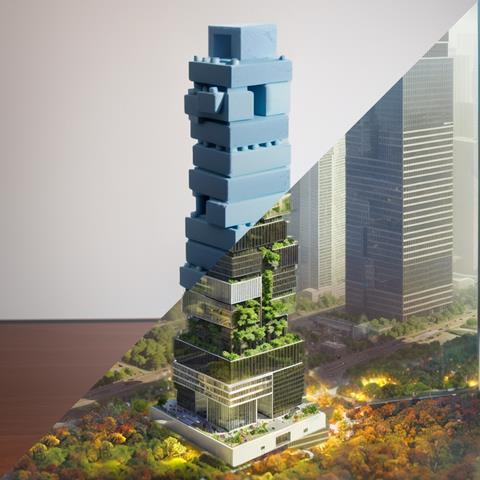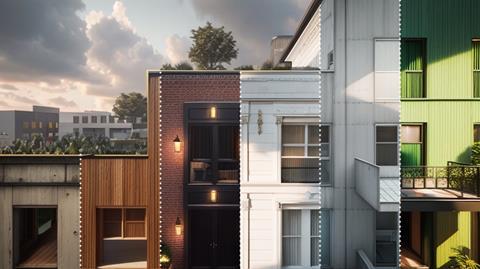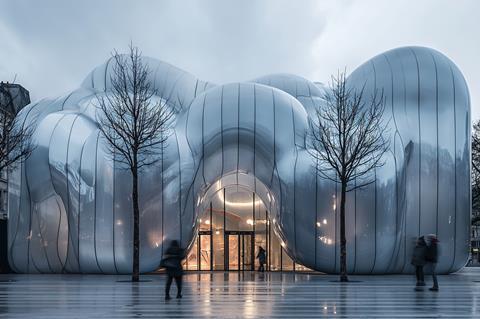Cas Esbach contemplates the massive opportunities - and potential pitfalls - presented by AI

In the ever-evolving realm of architecture, the conversation surrounding artificial intelligence (AI) has ignited significant fervour. Amidst accolades, cautionary tales from publications like Dezeen, The Guardian, and even Elon Musk resonate. Yet, as the world undergoes transformation, a decisive crossroads emerges: either welcome the winds of change or succumb to the current of progress.
This is a heartfelt plea to embrace AI.
The forthcoming generation of design tools will seamlessly intertwine with AI and image generation, affording architects more time to delve into quintessential design dilemmas. Let our collective passion, vision, and determination serve as the driving force to wholeheartedly embrace the impending evolution.
Empowered by advanced AI tools, architects can conjure semi-photorealistic images in mere seconds. This newfound efficiency liberates designers to dedicate extended periods to the creative facets of their craft, eliminating the weeks previously required to breathe life into a concept. This efficiency breakthrough unfolds through three pivotal aspects: ‘the brain hurricane,’ ‘the demise of blue foam,’ and ‘a surplus of time for genuinely exceptional ideas.’
A storm of creativity: From brainstorm to brain hurricane

In the embryonic stages of conceiving a new project, architects unleash their full creative arsenal. AI emerges as an invaluable collaborator right from the onset. Its knack for swiftly translating abstract ideas into tangible impressions enhances the creativity of the design team.
AI facilitates the rapid and intuitive visualisation of myriad concepts, shapes, materials, colours, and atmospheres. Bold ideas can now receive swift, preliminary visualisations, forming a robust foundation for the team to build upon. The decision-making process gains momentum, transforming the conventional brainstorm into a tempest of creative energy—the brain hurricane.
The sun is setting on ‘blue foam’ models

Traditional blue foam models, once the cornerstone of an architect’s early foray into physical modelling, now stand at the precipice of obsolescence. Recent years have seen their replacement by simple 3D models in software, often retaining their distinctive blue hue. However, these 3D models face overshadowing by AI image generators.
Early-stage design teams now wield the power of Midjourney and Stable Diffusion to craft compelling and imaginative images, unshackled from the constraints of rudimentary forms. Clients can now immerse themselves in the emotional and aesthetic dimensions of the design, free from the limitations of blue foam.
An expeditionary design process: Unlocking time for excellence
The impact of AI tools transcends mere acceleration; it elevates the very essence of projects. The rapid visualisation and testing of numerous design ideas, spanning shapes, materials, and colour schemes, dramatically reduces the time spent on extraneous options.
This surplus of time is then channelled into refining and perfecting genuinely outstanding ideas. In essence, AI empowers designers to focus on their true forte — designing — rather than squandering hours on fruitless endeavours like colouring drawings that lead nowhere.
An Ever-Changing Landscape

The threefold advantages of AI primarily orbit around visualisation. Yet, the future of AI remains shrouded in uncertainty, with potential avenues extending beyond mere visual representation. Envision a promising era of design tools emerging through AI integration into programs like Adobe.
Picture new BIM software where intricate design alterations are swiftly calculated without the need for manual intervention. These futuristic alterations, once consuming hours, now demand mere minutes. Architects, thus unburdened, can invest more time honing their core competency: designing.
However, before an unbridled embrace of AI in design processes, it is imperative to address potential pitfalls. While optimism for an AI-infused future persists, a nuanced understanding of its limitations remains crucial.
Beyond the triumphant narrative of the brain hurricane, the death of blue foam, and an abundance of time for quality designs, three substantial drawbacks loom: the risk of identity loss, the imperative to stay abreast, and the spectre of ‘power in the wrong hands.’
Loss of identity and diversity

AI tools like Midjourney and Stable Diffusion, while proficient, lack true intelligence. Their expertise lies in reproducing vast volumes of analysed data, devoid of intrinsic human qualities such as empathy, cultural sensitivity, and creative spontaneity. The consequences are already evident.
When tasked with rendering an ‘overgrown skyscraper,’ Midjourney produces a multitude of uniform imitations, lacking the visionary transcendence expected of architects. It underscores the architect’s responsibility to surpass present clichés in building the future and design within the nuanced context of place and time—an understanding AI seldom grasps.
This challenge is not insurmountable. Rather, it emphasises the need for a profound comprehension of AI tool limitations, or data literacy, to derive meaningful value from them. Designers must remain cognizant that present-day AI lacks genuine intelligence, necessitating a discerning choice of tools for specific purposes.
This awareness guards against the undue elevation of technology and encourages a critical approach. Designers, rather than relying solely on tools, must comprehend and contextualise their usage.
In simpler terms, learn the art of crafting prompts.
Keeping pace
The breakneck speed of AI advancements imposes not just technological pressures on architects but demands a fundamental reevaluation of their approach to design processes. This shift poses a formidable challenge for seasoned professionals, urging them to transition from an intuitive, hands-on approach to a more data-driven process.
Understanding the workings of AIs and their algorithms is no longer a luxury; it’s a necessity.
For newcomers entering the field, this poses a dual challenge: balancing the acquisition of technological skills and fundamental architectural knowledge. It is a challenge - albeit surmountable - requiring time, effort, and focused attention from educational institutions.
Power in the wrong hands
A final concern lies in the possibility of the developer’s side outpacing architectural firms in mastering AI. As tools become increasingly user-friendly, developers may create visionary image studies, blurring the lines between adept tool usage and genuine architectural prowess.
While design remains a skill, the aforementioned pitfalls persist. AI must not transform into an escape route for lackadaisical and uninspired architects, a sentiment echoed within the architectural community.
The question of now: Striking a balance
Amidst the urgency to act decisively, a collective discourse becomes imperative. The integration of AI into design processes must transpire judiciously, embracing opportunities while vigilantly addressing and sidestepping potential pitfalls.
In essence, the true value of AI must be carefully evaluated. It emerges as a novel addition to the architect’s toolkit, not a panacea. The decision lies in the hands of architects: will you ardently embrace the AI tide, or risk being engulfed by it?
Postscript
Cas Esbach is a project leader at MVRDV
















1 Readers' comment